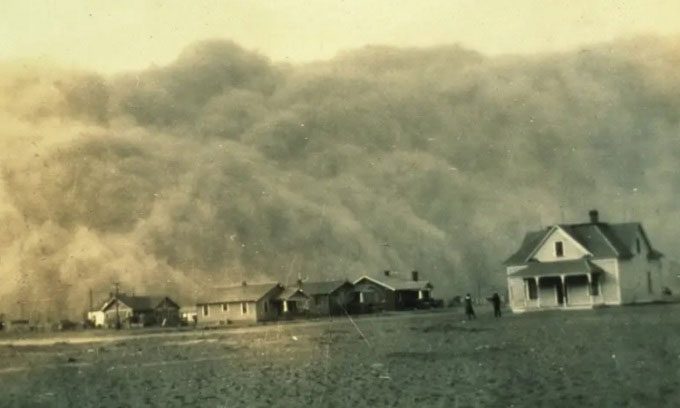The massive dust storms originating from agricultural mismanagement forced millions of Americans to abandon their homes and land during the 1930s.
Dust Bowl refers to the event that took place in the southern plains of the United States, where severe dust storms ravaged the area during a drought in the 1930s. As strong winds and dust clouds swept through the region from Texas to Nebraska, people and livestock perished, and crops failed throughout the region. The Dust Bowl exacerbated the economic impact of the Great Depression, pushing many farming families to migrate in search of jobs and better living conditions, according to History.

Dust storm hits Stratford, Texas in 1935. (Photo: Universal History Archive).
The Dust Bowl event was caused by several economic and agricultural factors, including federal land policies, changes in regional weather, and farming economics. After the Civil War, a series of federal land laws encouraged people to settle westward through farming in the North American Great Plains. The Homestead Act of 1862 granted settlers 65 acres of public land, followed by the Kinkaid Act of 1904 and the Enlarged Homestead Act of 1909. These laws led to a large influx of inexperienced farmers into the Great Plains.
Many settlers during the late 19th and early 20th centuries operated under a misconception. Settlers, land speculators, politicians, and even some scientists believed that farming and agriculture would positively influence the climate of the semi-arid Great Plains for cultivation. Years of wet weather deepened this misconception, leading people to farm increasingly on marginal lands where water for irrigation could not reach.
Rising wheat prices in the 1910s and 1920s, coupled with high demand for wheat from Europe during World War I, drove farmers to plow millions of acres of native grasslands to plant wheat, corn, and other crops. However, as the United States entered the Great Depression, wheat prices plummeted. In desperation, farmers turned to plowing even more grassland to harvest crops and break even.
Crops began to fail as drought set in starting in 1931, exposing vast tracts of farmland that had been tilled bare. Without deep-rooted prairie grasses to hold the soil in place, sandy soils were blown away. Soil erosion led to numerous massive dust storms that devastated the economy, particularly in the southern plains. The Dust Bowl event, also known as the “Dirty Thirties,” began in 1930 and lasted for about a decade, but its long-term economic impact on the region persisted far longer. A severe drought struck the Midwest and southern Great Plains in 1930. Dust storms raged in 1931. A series of drought years that followed only intensified the environmental disaster.
By 1934, an estimated 14 million acres of previously arable land became unplantable, while another 50 million acres, equivalent to three-quarters of the area of Texas, quickly lost their topsoil. Rainfall began to return to the area by the end of 1939, marking the end of the Dust Bowl. However, the population declined in the counties most heavily affected, where the agricultural value of the land could not recover until the 1950s.
Throughout the Dust Bowl period, the major dust storms, also known as “black blizzards,” swept across the Great Plains. Some carried topsoil from Texas and Oklahoma as far east as Washington, D.C., and New York, covering ships in the Atlantic Ocean with dust. The dust cloud darkened the sky, sometimes lasting for several days. In many places, dust drifted like snow, and residents had to shovel it away. Dust seeped through cracks into homes, settling on food, furniture, and human skin. Some residents suffered from “dust pneumonia,” experiencing chest pain and difficulty breathing. Authorities were uncertain of the exact number of deaths due to this condition, but estimates ranged from hundreds to thousands.
On May 11, 1934, a dust storm reaching heights of 3.2 kilometers traveled 3,200 kilometers to the east coast, blanketing landmarks such as the Statue of Liberty and the Capitol building. The worst dust storm occurred on April 14, 1935. News outlets referred to it as Black Sunday. A towering wall of sand and dust formed from the Panhandle of Oklahoma and spread eastward. An estimated 3 million tons of topsoil were blown away from the Great Plains in just that Sunday.
President Franklin D. Roosevelt implemented several measures to assist the impoverished farmers who had lost their homes. He also addressed the environmental degradation that led to the Dust Bowl. Government programs encouraged farmers to plant windbreaks on farms throughout the Great Plains. Government agencies also developed and promoted various new farming techniques to combat soil erosion. Approximately 2.5 million people migrated from states affected by the Dust Bowl such as Texas, New Mexico, Colorado, Nebraska, Kansas, and Oklahoma during the 1930s. This was one of the largest migrations in American history.


















































